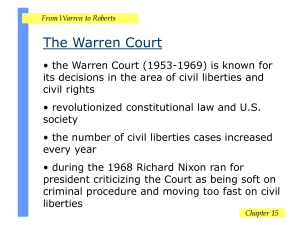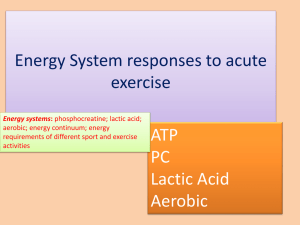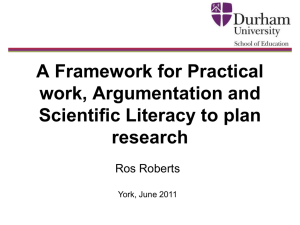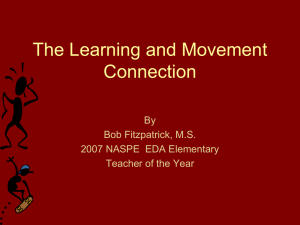Chris Cheyette - Play your carbs right?
advertisement
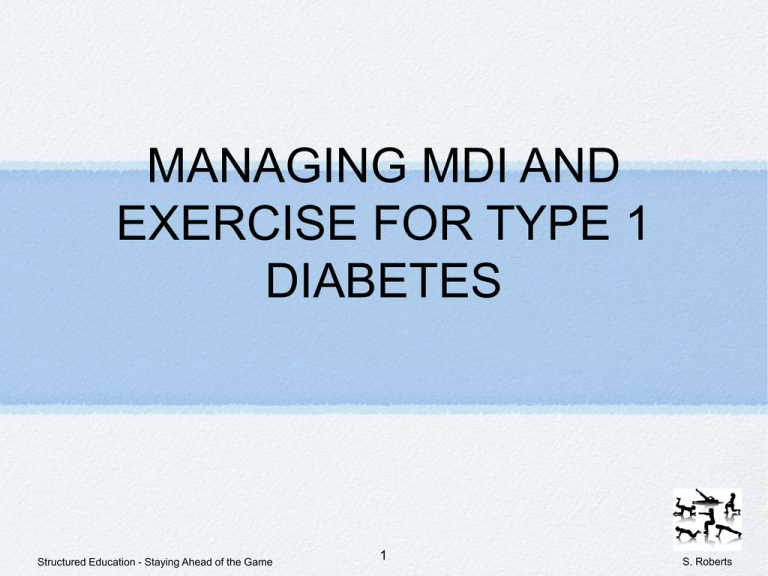
MANAGING MDI AND EXERCISE FOR TYPE 1 DIABETES Structured Education - Staying Ahead of the Game 1 S. Roberts Learning Outcomes 1. To know the key questions to ask patients with Type 1 diabetes, who require advise on exercise 2. To gain a basic understanding of the bodies physiological response to and consequent effect on blood glucose levels, from taking part in aerobic, anaerobic or mixed aerobic/anaerobic activities 3. To know how to safely advise Type 1 patients on MDI (Multiple Daily Injections) on adjustment of insulin dosage and taking in extra carbohydrates required for aerobic, anaerobic and mixed aerobic/anaerobic activities. Structured Education - Staying Ahead of the Game 2 S. Roberts Key Questions To Ask Key questions to ask patients with Type 1 diabetes, who require advise on exercise Structured Education - Staying Ahead of the Game 3 S. Roberts Key Questions To Ask Questions about the person! Questions about the persons diabetes! Questions about the person & exercise! Structured Education - Staying Ahead of the Game 4 S. Roberts Key Questions To Ask Feedback...! Structured Education - Staying Ahead of the Game 5 S. Roberts key questions to ask Structured Education - Staying Ahead of the Game 6 S. Roberts Questions About The Persons Why do you want to start exercising? What experience do you have with exercise? What are your short, medium and long term goals? Structured Education - Staying Ahead of the Game 7 S. Roberts Questions About The Persons Diabetes How long have you had diabetes? Do you suffer any complications? (feet, eyes, blood pressure etc.,) How is your general diabetes management? (good, sub-optimal etc.,) How often do you check your blood sugars? What does your blood sugar profile look like now? How much support do you currently get to managed your diabetes? Have you had any structured diabetes training? (DAFNE etc) Are you familiar with what happens to your blood sugar during and after exercise? Do you have any other medical conditions which could affect your ability to exercise? Structured Education - Staying Ahead of the Game 8 S. Roberts Questions About The Exercise Type, Is it structured and planned Frequency, Duration, Intensity, Previous Experience, Structured Education - Staying Ahead of the Game 9 S. Roberts The Bodies Physiological Response Basic understanding of the bodies physiological response to and consequent effect on blood glucose level of aerobic, anaerobic and mixed aerobic/anaerobic exercise. Structured Education - Staying Ahead of the Game 10 S. Roberts Physical Activity - Exercise • Physical activity • Exercise Structured Education - Staying Ahead of the Game 11 S. Roberts Physical Activity - Exercise PHYSICAL ACTIVITY Any bodily movement produced by skeletal muscle that result in energy expenditure. So that includes a broad spectrum of activities, including occupational, leisure and routine daily activities Heart Disease and Diabetes 2003 Structured Education - Staying Ahead of the Game 12 S. Roberts Physical Activity - Exercise EXERCISE This is a component of physical activity and describes physical activity, which is planned and structured and done to improve and or maintain physical fitness Heart Disease and Diabetes 2003 Structured Education - Staying Ahead of the Game 13 S. Roberts The Bodies Physiological Response Basic understanding of the bodies physiological response to and consequent effect on blood glucose level of aerobic, anaerobic and mixed aerobic/anaerobic exercise. Structured Education - Staying Ahead of the Game 14 S. Roberts The Bodies Physiological Response Why use these terms; aerobic and anaerobic? As these are the two energy systems used during physical activity and exercise. www.teachpe.com/anatomy/energy_systems.php Structured Education - Staying Ahead of the Game 15 S. Roberts The Bodies Physiological Response The terms aerobic and anaerobic? Literally mean ‘with oxygen’ and ‘without oxygen’ respectively. When describing exercise these terms were originally used at a time when it was believed that your ability to continue exercising was related to the availability of oxygen. It is now understood that the muscles always have plenty of oxygen, but its the intensity and duration of exercise that dictates the percentage contribution from the various different energy systems. So, marathon running is largely aerobic but still has a contribution from anaerobic sources whilst 100m sprinting is largely anaerobic but still has a contribution from aerobic sources. And theres a large spectrum of activities which fall between these extremes. For example 400m running may be 50% aerobic and 50% anaerobic. Runsweet.com - Gallen, Ian W, - Godfrey, Richard Structured Education - Staying Ahead of the Game 16 S. Roberts The Bodies Physiological Response The terms aerobic and anaerobic? Literally mean ‘with oxygen’ and ‘without oxygen’ respectively. Runsweet.com - Gallen, Ian W, - Godfrey, Richard Structured Education - Staying Ahead of the Game 17 S. Roberts The Bodies Physiological Response The terms aerobic and anaerobic? Literally mean ‘with oxygen’ and ‘without oxygen’ respectively. When describing exercise these terms were originally used at a time when it was believed that your ability to continue exercising was related to the availability of oxygen. It is now understood that the muscles always have plenty of oxygen, but its the intensity and duration of exercise that dictates the percentage contribution from the various different energy systems. So, marathon running is largely aerobic but still has a contribution from anaerobic sources whilst 100m sprinting is largely anaerobic but still has a contribution from aerobic sources. And theres a large spectrum of activities which fall between these extremes. For example 400m running may be 50% aerobic and 50% anaerobic. Runsweet.com - Gallen, Ian W, - Godfrey, Richard Structured Education - Staying Ahead of the Game 18 S. Roberts The Bodies Physiological Response • Aerobic energy system • In this context ‘aerobic’ refers to the fact that oxygen is required in the process whereby carbohydrates and fats are oxidised (burned) completely to make a compound called ATP (which is the prime energy source of all cells). Typically endurance sports require energy from predominantly aerobic sources. Runsweet.com - Gallen, Ian W, - Godfrey, Richard Structured Education - Staying Ahead of the Game 19 S. Roberts The Bodies Physiological Response • Anaerobic energy system • This system provides energy in the absence of Oxygen. • This system is used in the first few minutes of all exercise, before there is sufficient oxygen available at the muscles for aerobic metabolism to kick in. It’s also used for fast, powerful bursts of energy, for which the aerobic system is insufficient Runsweet.com - Gallen, Ian W, - Godfrey, Richard Structured Education - Staying Ahead of the Game 20 S. Roberts The Bodies Physiological Response • Aerobic/Anaerobic energy system • As the intensity of exercise increases there is an increasing contribution from anaerobic sources and a decreasing contribution from aerobic sources. Runsweet.com - Gallen, Ian W, - Godfrey, Richard Structured Education - Staying Ahead of the Game 21 S. Roberts The Bodies Physiological Response • Recap - Aerobic/Anaerobic energy systems • The aerobic system produces the largest amounts of energy, although at the lowest intensity. • At the start of exercise the body cannot deliver oxygen to the muscles fast enough to initiate a complex chemical reaction required during aerobic metabolism. Therefore the body relies on anaerobic processes for the first couple of minutes. www.teachpe.com/anatomy/energy_systems.php Structured Education - Staying Ahead of the Game 22 S. Roberts Exercise And Diabetes, What Happens? • During exercise, your blood glucose goes up and down, depending upon the type of exercise; • During short periods of anaerobic exercise, or exercise with short explosive bursts of activity, your glucose levels may rise; • In contrast, glucose levels generally fall with prolonged aerobic exercise. Hypoglycaemia after exercise can also be a problem. Runsweet.com - Gallen, Ian W, - Godfrey, Richard Structured Education - Staying Ahead of the Game 23 S. Roberts Key Questions To Ask Know how to safely advise Type 1 patients on MDI on adjustment of insulin dosage, taking on extra carbohydrate required for aerobic, anaerobic and mixed aerobic/anaerobic activities. Structured Education - Staying Ahead of the Game 24 S. Roberts To know How To Safely Advise Type 1 Patients On MDI Metabolic Control Before Exercise Start exercise blood glucose levels should be between 7-12mml. Consider consuming extra carbohydrate at the start if levels are <7. For levels >12mml without ketosis delay glucose replacement during exercise until glucose has fallen. • Avoid exercise if ketosis is present. Structured Education - Staying Ahead of the Game 25 S. Roberts To know How To Safely Advise Type 1 Patients On MDI Food Intake Consume additional carbohydrate as needed to avoid hypoglycaemia. As a general guide for moderate intensity endurance activities high glycaemic index carbohydrate should be consumed after 20minutes of exercise at a rate of up to approximately 1g/kg/hr. Lower intensity activities or intermittent high intensity activities are likely to require smaller rates of carbohydrate supplementation. Carbohydrate-based foods with a high glycaemic index should be readily available during and after exercise. Adequate hydration is essential. Runsweet.com - Gallen, Ian W, - Godfrey, Richard Structured Education - Staying Ahead of the Game 26 S. Roberts To Know How To Safely Advise Type 1 Patients On MDI Blood Glucose Monitoring Before, During and After Exercise Measure blood glucose before, every 30minutes during and at the end of exercise. Identify when changes in insulin or food intake are necessary, where possible sudden unaccustomed changes should be avoided e.g. if a reduction in insulin is thought to be required trial a 20% reduction insulin first don’t jump straight to a 75% reduction. Runsweet.com - Gallen, Ian W, - Godfrey, Richard Structured Education - Staying Ahead of the Game 27 S. Roberts To Know How To Safely Advise Type 1 Patients On MDI General Safety Where possible avoid exercising alone and alert others to potential signs of hypoglycaemia. Extra care should be taken when exercising after a recent hypoglycaemic episode as risk of hypoglycaemia during exercise is increased. Runsweet.com - Gallen, Ian W, - Godfrey, Richard Structured Education - Staying Ahead of the Game 28 S. Roberts Live Web-Surfing REPs - Register of Exercise Professionals www.exerciseregister.org www.runsweet.com www.brianmac.co.uk www.teachpe.com 29 Live Web-Surfing REPs - Register of Exercise Professionals www.exerciseregister.org Structured Education - Staying Ahead of the Game S. Roberts Structured Education - Staying Ahead of the Game Structured Education - Staying Ahead of the Game S. Roberts S. Roberts S. Roberts Structured Education - Staying Ahead of the Game S. Roberts Structured Education - Staying Ahead of the Game S. Roberts Structured Education - Staying Ahead of the Game S. Roberts Structured Education - Staying Ahead of the Game S. Roberts Structured Education - Staying Ahead of the Game S. Roberts Structured Education - Staying Ahead of the Game S. Roberts Structured Education - Staying Ahead of the Game S. Roberts Live web-surfing www.runsweet.com Structured Education - Staying Ahead of the Game 41 S. Roberts Live web-surfing www.brianmac.co.uk Structured Education - Staying Ahead of the Game 43 S. Roberts Live web-surfing www.teachpe.com Structured Education - Staying Ahead of the Game 44 S. Roberts Live Web-Surfing Can three minutes of exercise a week help make you fit? www.bbc.co.uk/news/health-17177251 Structured Education - Staying Ahead of the Game 45 S. Roberts about me! Structured Education - Staying Ahead of the Game S. Roberts

